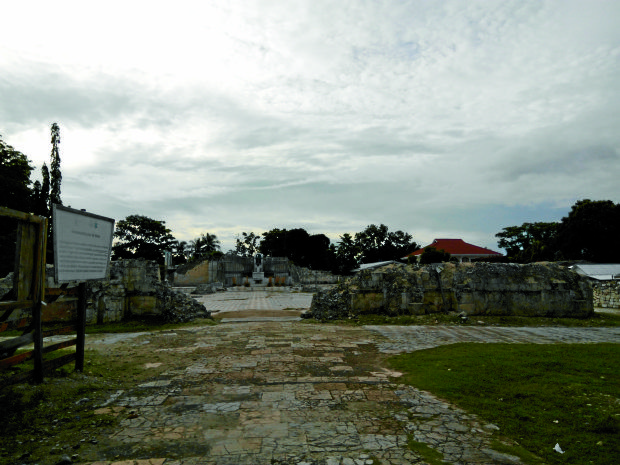
The Nuestra Señora de la Luz in Loon town was the biggest church in Bohol province before it was reduced to a pile of rubble with no structure left at all. After three years, the restoration has not yet started . LEO UDTOHAN/INQUIRER VISAYAS
(Conclusion)
The situation in the province, though, is far from normal.
In Sagbayan town, officials and employees continue to hold office inside makeshift structures since the reconstruction of the town hall is expected to be completed next year. Commerce, however, has returned, with the market open since
August.
In Loay town, the reconstruction of the town hall, considered to be a national treasure, was stopped by the National Historical Commission of the Philippines. Officials hold offices in makeshift structures in front of the destroyed town hall.
The reconstruction of the town halls of Tubigon, San Isidro and Antequera was finished early this year. However, only the Antequera town hall was occupied in March.
Town halls in Loon, Balilihan and Cortes have yet to be reconstructed.
Heritage churches
The restoration of the damaged churches are ongoing. These include the Sta. Monica Parish Church in Alburquerque, Immaculada Concepcion de la Virgen Maria in Baclayon, San Agustin Parish Church in Panglao, Our Lady of Assumption Church in Dauis, Sto. Niño Parish Church in Cortes, Church of the Holy Trinity in Loay and Saint Nicholas Tolentino Church in Dimiao.
But work on several churches has not started due to the extent of damage. These are the Parroquia de la Santa Cruz in Maribojoc, Nuestra Señora de la Luz in Loon, and St. Peter the Apostle Church in Loboc.
Heavily damaged school buildings were either repaired or replaced with new structures.
At least 1,260 classrooms in Bohol were destroyed by the earthquake. The Department of Education initially used its quick response fund and savings to repair and rebuild a number of classrooms.
Many students now attend classes in better-built schools, some of which were donated by private foundations and charity groups.
At Sagbayan Central Elementary School, there is no trace that structures there were flattened by the quake. Teachers and pupils have been using 21 classrooms since Oct. 15, 2015. And construction at two primary schools have been abandoned due to problems with contractors.
In Loon town, 214 pupils of Napo Elementary School are still occupying makeshift classrooms made of handwoven bamboo slats.
Construction of the two-story school building in Cogon Norte Elementary School, also in Loon, was stopped in the second of week of September due to unavailability of materials. As of Sept. 27, only five classes at Loon South Central Elementary School were held in tents.
Tourism revival
There are encouraging signs that Bohol, three years after it was devastated by a 7.2 magnitude earthquake, has not lost its reputation as a major tourist drawer.
Bohol is among the country’s top destinations due to its rich history and culture and as a natural habitat of the world’s smallest primate, the tarsier, and the home of the Chocolate Hills.
But its tourism industry was among those that was crippled by the earthquake.
After three years, however, tourism has bounced back mostly due to the rehabilitation of tourist spots, rebranding and development of new attractions.
Records from the Bohol Tourism Office showed that
arrival increased by 45.15 percent in 2015 compared to 2013 and 2014, a good sign according to Neil Reyes, team leader of
the research and statistics
department.
Some tourist attractions in the province were restored like the Inang-angan, a coral stone stairway of five flights and 212 steps, which was declared a national cultural treasurer by the National Museum.
The Punta Cruz Watchtower in Maribojoc was also restored last month. It stands tall
over the uplifted coastal areas, now considered a geological monument.
Resorts have been sprouting in the popular Panglao Island as travelers looking for a more quiet and relaxed atmosphere seek out its exclusive resorts.
Totsie Escobia, head of Effective Development Communication Unit (Edcom)-Bohol, said some tourists come to the province to see for themselves the impact of the tragedy on the island.
The earthquake also taught Boholanos to be better prepared for disasters, especially at the community level.
At Cogon Norte Elementary School in Loon town, one of the hardest-hit areas, school officials adopted the use of
kuratong—a bamboo communication device—to warn students and teachers of possible calamities.
Kuratong is traditionally used to call community members to assemble at village halls for meetings, alert people or call children home.
Elementary school teacher Inocencia Reyes said the school revived the use of kuratong as part of disaster risk reduction efforts, especially when earthquakes strike.
“In case of power disconnection, we can use kuratong to alert our students since no one knows when an earthquake will happen,” she said, noting teachers and students were trained in using the device.
But the pain lingers for many survivors.
For Genara Somoro, the picturesque Bayong falls in Sagbayan town, is a source of painful memories.
Her two daughters and three of their friends were swimming in the area when the temblor struck, triggering a landslide that buried the children. Their bodies were never found.
“I have recovered after three years, but I cry when I remember my children,” Somoro said.
RELATED STORIES
Day of prayer, thanksgiving: Bohol remembers 2013 quake
Bohol traditions a balm for quake wounds